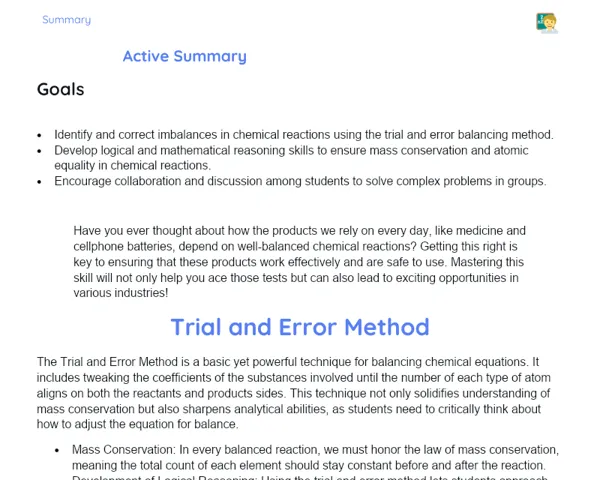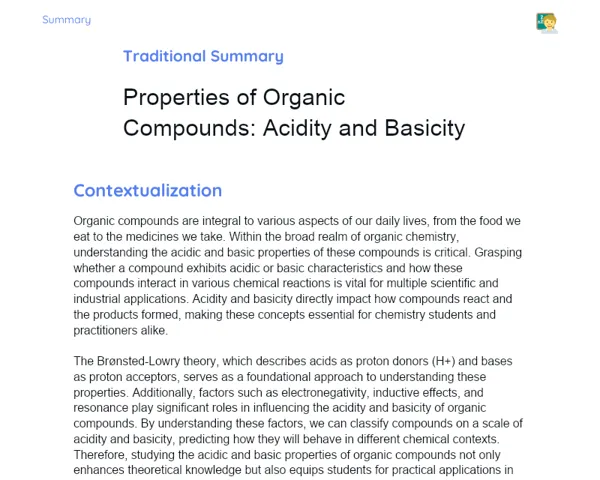Socioemotional Summary Conclusion
Goals
1. Understand that ether is defined by an oxygen atom bonded to two different carbon atoms.
2. Identify the properties and characteristics of ethers.
3. Connect the properties of ethers to their applications in the real world.
Contextualization
🧪✨ Did you know that diethyl ether was among the first anesthetics used in surgeries? This breakthrough transformed medicine, allowing for more complex and less painful operations! Moreover, ethers are present in various fragrances and are used as industrial solvents. Grasping the properties of ethers not only enhances our understanding of chemistry but also illuminates their relevance in our everyday lives and society. Ready to dive into this intriguing realm? 🚀
Exercising Your Knowledge
Definition and Structure of Ethers
Ethers are organic compounds identified by the functional group R-O-R', where 'R' and 'R'' represent alkyl or aryl groups. The general formula for ethers is R-O-R', with oxygen forming two sigma bonds with carbon atoms. Take diethyl ether, for instance, which is written as CH3CH2-O-CH2CH3. These compounds are quite diverse and are useful in multiple applications, ranging from anesthesia to fragrances.
-
Chemical Composition: Ethers consist of an oxygen atom connecting two alkyl or aryl groups, forming the R-O-R' structure.
-
Structural Diversity: The nature of groups R and R' can differ greatly, resulting in a wide variety of ethers.
-
Classic Example: Diethyl ether (CH3CH2-O-CH2CH3) is a prime example, historically utilized in medicine as an anesthetic.
Physical Properties of Ethers
Ethers exhibit distinct physical properties that dictate their applications. They have relatively low boiling points as they don't form hydrogen bonds between their molecules, which makes them quite volatile. Their solubility varies; they are moderately soluble in water yet highly soluble in organic solvents, which supports their use in various industrial settings.
-
Boiling Point: Ethers have low boiling points due to the absence of hydrogen bonding.
-
Solubility: They are moderately soluble in water but highly soluble in organic solvents.
-
Use as Solvents: Ethers are widely regarded as industrial solvents in a range of applications because of their solubility.
Chemical Properties and Reactivity of Ethers
While ethers are generally stable and less reactive than many other organic compounds, they can develop explosive peroxides when exposed to air for extended periods. This limited reactivity supports their widespread use as solvents and in other industrial contexts but necessitates careful handling to mitigate risks.
-
Chemical Stability: Ethers tend to be stable and have lower reactivity compared to many organic compounds.
-
Peroxide Formation: Long exposure to air may result in the formation of dangerous peroxides.
-
Handling Precautions: It is essential to store and handle ethers cautiously due to the risk of peroxide development.
Practical Applications of Ethers
Ethers have a multitude of practical applications demonstrating their significance in our daily routines and industrial settings. In medicine, diethyl ether was one of the earliest anesthetics. In perfumes and cleaning products, ethers are frequently used for their ability to dissolve substances. These instances highlight ethers' practical relevance and significance across various contexts.
-
Medicine: The historical role of diethyl ether as an anesthetic, revolutionizing surgical practices.
-
Fragrances: The use of ethers in perfumes owing to their solubilizing properties.
-
Industrial Solvents: Ethers are commonly used as solvents in numerous industrial processes and cleaning supplies.
Key Terms
-
Ether: An organic compound characterized by the R-O-R' structure, with R and R' as alkyl or aryl groups.
-
Solubility: The ability of a substance to dissolve in another, crucial for ethers' functionality as solvents.
-
Peroxides: Compounds that may be produced by ethers when exposed to air, potentially hazardous due to their explosive nature.
For Reflection
-
In what ways did diethyl ether's introduction into medicine revolutionise surgical methods, and how does this shape our views on scientific progress?
-
Considering the risk of explosive peroxides, what safety practices should we implement when working with ethers in the lab?
-
How can an understanding of ether's properties inform our choices regarding products containing them in our daily lives?
Important Conclusions
-
Ethers are organic compounds that involve the functional group R-O-R', where oxygen is attached to two different carbon atoms.
-
They have unique physical properties, like low boiling points and varying solubility, which impact their uses.
-
Ethers are widely applied in medicine, industry, and daily products including anesthetics, solvents, and fragrances.
-
A solid understanding of ethers' chemical and physical properties empowers us to use these substances safely and effectively.
Impacts on Society
Ethers hold a significant place in our modern society. For example, diethyl ether was one of the first anesthetics used in operations, paving the way for substantial advancements in healthcare and easing patients' suffering. Moreover, the use of ethers as solvents and in fragrances underscores their relevance in our everyday lives, from cosmetics to cleaning product manufacturing.
On an emotional level, recognising the importance of ethers helps us appreciate the need for safety practices. The potential formation of explosive peroxides teaches us the value of being cautious and thorough when handling chemicals. This awareness fosters responsible decision-making and a respect for scientific safety measures in our daily activities.
Dealing with Emotions
To help manage your emotions while delving into this topic, I recommend the RULER approach: start by noticing how you feel when studying ethers (perhaps curiosity, nervousness, or excitement). Reflect on what triggers these emotions (which could stem from content complexity or novelty). Clearly label these feelings. Next, find ways to express these emotions appropriately—talk to a colleague, write about it, or even sketch. Finally, regulate your emotions by practicing relaxation techniques, such as deep breathing or taking breaks to alleviate any study-related pressure.
Study Tips
-
Review your notes each day to reinforce your retention of information regarding the properties and uses of ethers.
-
Form study groups to discuss the topic and clarify assumptions with classmates, which enhances collective understanding.
-
Look for videos and documentaries about ethers' practical applications, particularly their historical relevance in medicine, to deepen your understanding of the content.



